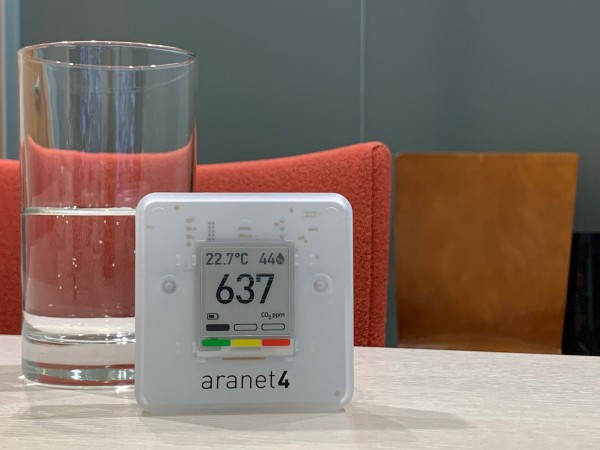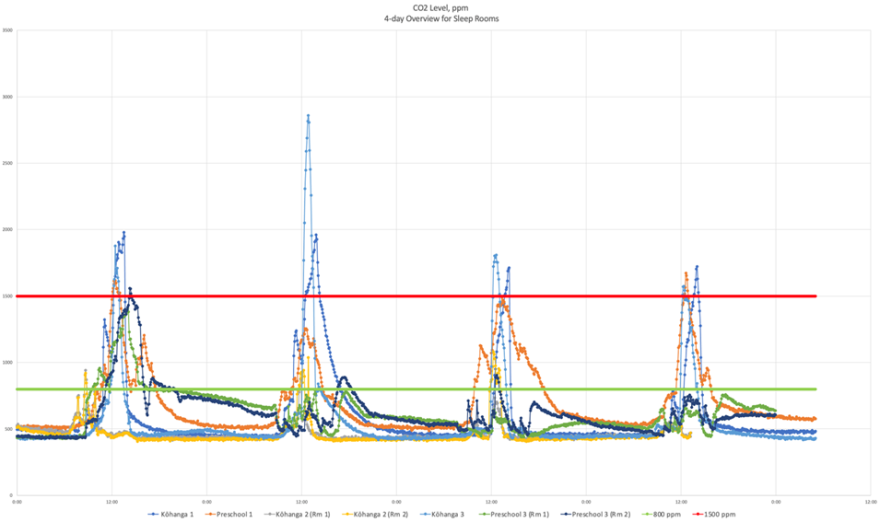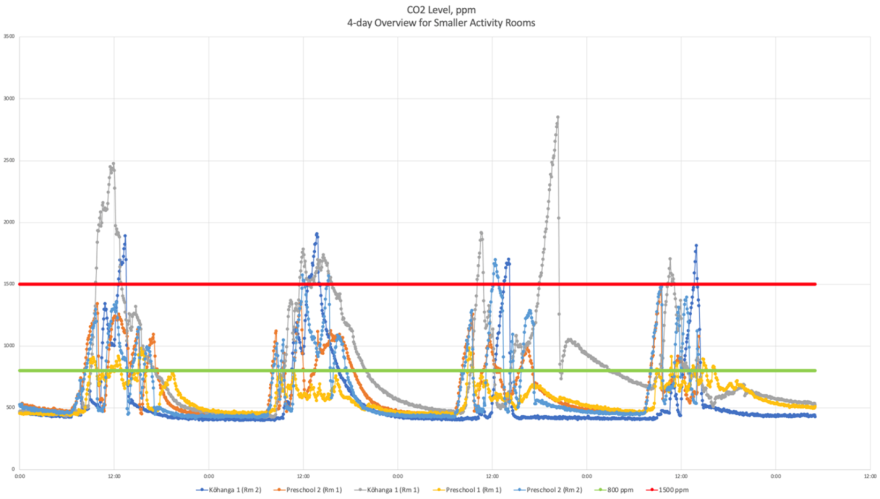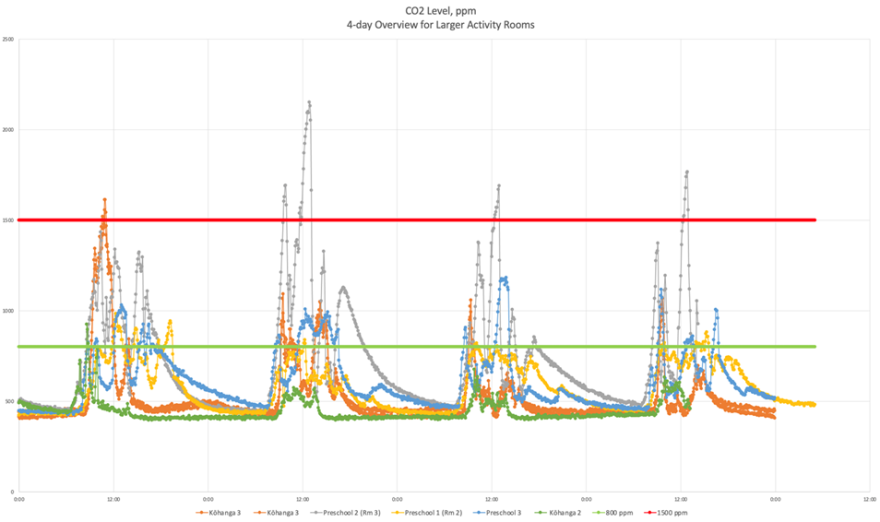Summary
Good ventilation is considered to be an important way to reduce the transmission of respiratory viruses in indoor spaces where people gather and spend time.1
In this study run by medical students, the CO2 levels were measured in six randomly chosen early childhood centres in northern Taranaki during June and July 2022. High levels of CO2 (over 1,500ppm) were found in four out of the six early childhood education centres (ECE).
While schools throughout Aotearoa New Zealand have been supplied with CO2 monitors, ECEs have not despite being known to have high levels of respiratory virus transmission at times.
Aotearoa New Zealand, alongside many other developing countries, has seen a dramatic increase of children in early childhood education (ECE) environments in recent years2. Over 68% of children at two years of age are currently in some sort of formal care, with that figure up to 84% at age four2.
Respiratory viruses and the respiratory infections caused by them are unfortunately part of the daily life of children attending early childhood education3. There have also been high levels of Covid-19 infection and hospitalisation rates in this age group4. Children under five years are currently not vaccinated against Covid-195 and are too young to wear masks.
Monitoring CO2 in early childhood centres
The purpose of this research was to assess the levels of carbon dioxide (CO2) in a sample of early childhood education centres to determine ventilation levels and the risk of respiratory virus transmission. Six randomly chosen ECE centres from a total of 55 centres in New Plymouth and Waitara were involved in an observational study during June and July 2022. The ECE centres were initially contacted by phone and a letter was emailed to formally invite them to participate in the study. All six centres confirmed they were willing to be involved in the study.
CO2 levels in both activity rooms and sleep rooms were measured using an Aranet4 monitor for a minimum of four days. Good ventilation was defined as less than 800 parts per million (ppm) and 1,500 parts per million of CO2 was defined as high.
It was found that ventilation levels were not optimal at times in four out of six facilities. Four out of seven sleep rooms, three out of five smaller activity rooms (<150m³) and two out of five larger activity rooms (>150m³ in area) reached levels of CO2 more than 1,500ppm. (See Charts One, Two and Three in the Appendix.) The number of children per room with CO2 levels above 1500ppm varied from 5-15 children in the sleep rooms, 10-20 children in the smaller activity rooms and 10-25 children in the larger activity rooms. Two out of the four sleep rooms with high CO2 levels did not have windows able to be opened but all the rest of the rooms either had windows or sliding doors that could be opened. None of the monitored rooms exceeded 3000ppm at any time.
It is likely that poor ventilation is a feature for many ECE centres all around New Zealand. The findings in this study in Taranaki are consistent with what has been found in similar studies undertaken in schools6, and in ECE centres in Auckland7. Utilising CO2 monitors in spaces such as sleep rooms could provide practical help to ECE centres with their ventilation status.
All ECE centres involved in this study showed great interest in the results and what actions they could take to make the children’s environments healthier. This is especially important with the potential of future Covid-19 variants. Reducing CO2 levels in an educational environment has other benefits as well. High levels are linked to poor concentration, impaired cognitive performance, and higher rates of absenteeism8,9. The results of ventilation monitoring have applications to both the children at the centre and also for the health and well-being of staff and helpers.
This small project has shown that shown that CO2 monitors can better identify a space’s ventilation status and thus could play a role in reducing respiratory virus transmission. An article published in 2022 looked at the pros and cons of CO2 monitors and discussed the need of raising public awareness around the importance of ventilation. It was concluded that while CO2 monitors only give information on one of the factors related to disease transmission they at least help “make an invisible problem visible”10.
Two main recommendations are made:
- Free CO2 monitors should be supplied by the Ministry of Education to all ECE centres before winter 2023 in the same way they were provided to all state and state-integrated schools in 2022. They are relatively cheap (about $380- $450 per unit) and are currently the only effective way of measuring ventilation.
- Public Health Services around the country consider setting up “lending libraries” with CO2 monitors to allow for groups and organisations with an interest in health and well-being to evaluate their usefulness over a period of a few weeks. This may motivate these organisations to then buy such monitors for themselves and improve ventilation in their premises.
What is new in this Briefing
- This small ventilation study measured the CO2 levels in six randomly chosen early childhood centres in northern Taranaki during June and July 2022.
- It found high levels of CO2 (over 1,500ppm) in four out of the six early childhood education centres (ECEs) – indicative of poor ventilation.
Implications for public health practice and policy
- Free CO2 monitors should be supplied by the Ministry of Education to all ECEs before winter 2023.
- Public Health Services around the country could consider setting up “lending libraries” with CO2 monitors to allow for groups and organisations with an interest in health and well-being to evaluate their usefulness over a period of a few weeks. This may motivate these organisations to then buy such monitors for themselves and improve ventilation in their premises.
Author details:
Jaimee Paterson, Grace George and Sam George were 6th year medical students (trainee interns) on a public health elective from the University of Otago at the time the study was undertaken.
Dr Jonathan Jarman (Jonathan.Jarman@hotmail.com) is a public health medicine specialist and former Medical Officer of Health in Taranaki.
Appendices
Chart One. Four Day Overview for Sleep Rooms
Chart Two. Four Day Overview for Smaller Activity Rooms
Chart Three. Four Day Overview for Larger Activity Rooms




